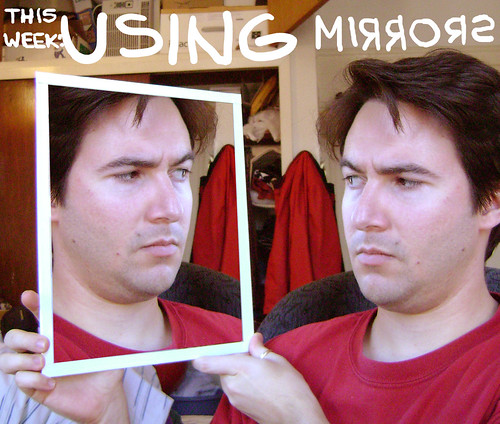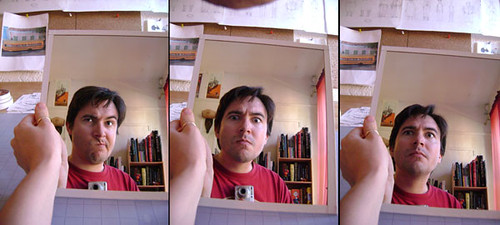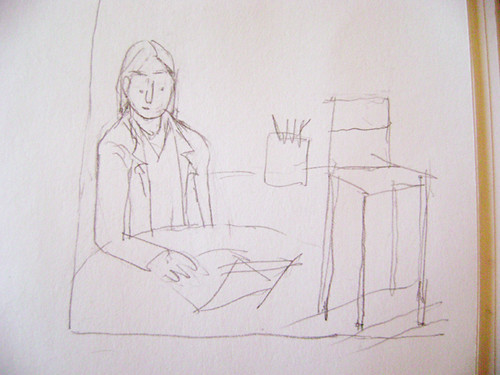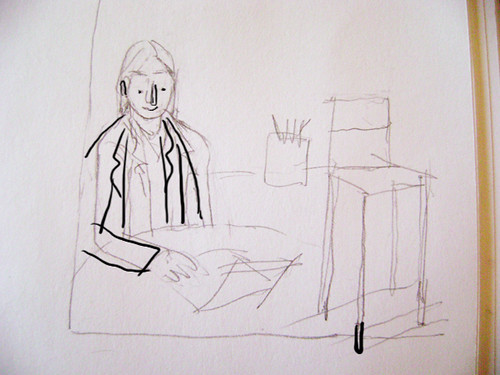
My mirror is the most important, indispensable tool I own. Take any of my other tools or materials- my pens, my brushes, my inks, my table and chair- I can always just use something else and still make comics. But without my page-sized dollar store mirror, I'd be up a certain creek without a certain kind of stick.
Most people who think of a cartoonist using a mirror think of them using it to reference facial expressions, and indeed I do do that, as you can see:

But that's actually not what I use it most for. I use it to find flaws in drawings that I can't quite figure out right-ways.
We've all had the experience where we spend hours looking at a drawing, re-drawing this detail and that detail, but something that we can't quite put our finger on still looks wrong with it. For some reason, holding up a mirror to that drawing is like putting on ghost-detecting glases: all the problems you could sense were there but couldn't quite see are thrown into horrifying clarity. Below, I've done a doodle based on a drawing a friend recently asked help with, and I've added two of my own most common, mirror-fixable problems to it. As you can see, there's clearly things wrong with the drawing, but it might not be immediately clear what exactly is wrong or how to fix it:

Now, let's flip the image around and look at it:

Flipped around, it becomes much easier to see the problems.
Have a look at the shoulder and elbow: it's easy to see how that the artist was running out of room and tried to fit the whole figure into the picture. This tendency to distort things while trying to cram them in is a common mistake, especially when people draw from life, where they don't plan out the composition and start drawing only to find that what they want to draw will run off the page. Try to think of the edges of your drawing as the rectangular hole in a piece of cardboard that you're holding in front of your face to look at what you're drawing, and not some sort of suitcase that you have to jam everything into. If something is running off the edge that you want in the drawing, move the rectangle around. Maybe it needs to be more to the side. Maybe you need to back up more. Maybe you need a differently shaped rectangle. Rearrange the rectangle around the stuff you want to draw, not the other way around.
Now look at the face. This is my most common mistake: I often don't put the features on the face in a way that matches the plane of the face. It's a mistake that stems from my difficulty in imagining the face in 3 dimensions, because I ignored faces in life drawing class. I'm exaggerating a little for effect here, but I really do often find that when I look at a face that seems wrong in the mirror, the features are too high, too low, or off to one side. Once you can see it, it's an easy fix.
Now look at the chair legs. In this case, you can see that it was distorted because it was going to run off the edge, but even when that's not the problem I find that I can't draw in perspective without a mirror. It allows me to see if a figure seems too small or large, and other very subtle mistakes. Generating a believable space is hard even for the most gifted pros, and artists need all the help they can get.
Here's the drawing with my corrections over it:

The best place to get a mirror is a dollar store. They have cheap, rectangular mirrors roughly the size of a comic page, which allows you to set the mirror next to your art and see the reversed page sitting next to your real art. Sometimes I'll even draw my corrections in the mirror, glancing back and forth as I go. This kind of mirror will be about 3 bucks. It comes in a terrible frame that I always tear off. Then I tape the edges and back, so if it breaks it won't get glass everywhere.
Mirrors aren't just great for anatomy and perspective, they can help you see problems with composition, too. And they're great and finding problems in type, which is all about the positive and negative spaces being even and pleasing. A mirror will let you see odd gaps in your type. All my graphic designer friends view their type in reverse to check it as they go.
If you're like me, as you've been reading this you've wanted to jump up and look at all your old drawings to check for mistakes. DON'T DO THAT. You will want to kill yourself. What's drawn is drawn; move on and draw new things.
Next week's tool: light.
If anyone has any of their own images whose flaws reveal themselves in reverse that they'd like to share for some masochistic reason, send them to contact@matthew-bernier.com.

1 comment:
Another useful tool for "flipping" is a lightbox if you have one. Not only can you reverse the image, but you can draw away on the flip side making corrections and then turn it back over and incorporate the changes.
Post a Comment